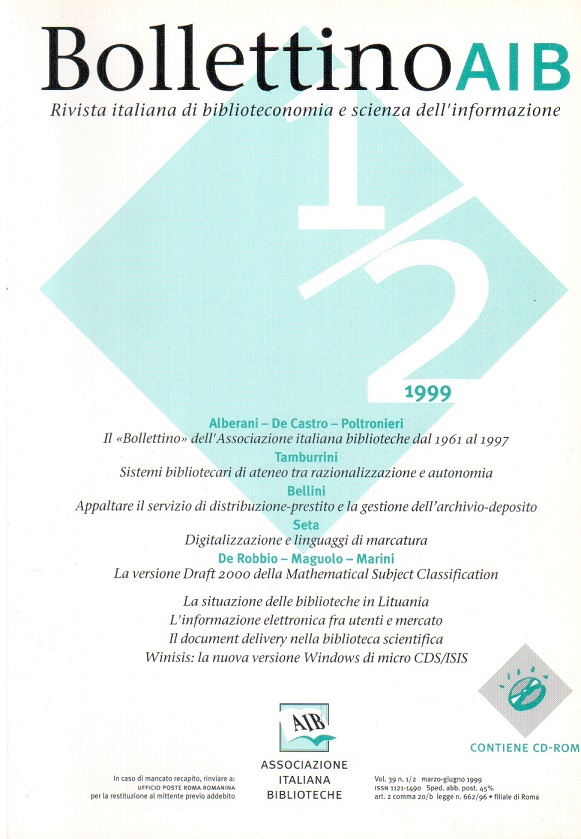The version Draft 2000 of the Mathematics subject classification: how is mathematics moving on?
Main Article Content
Abstract
A summary framework of the conceptual, formal and functional dynamics of classifications, thesauri and subject cataloguing guides indicates that comparative analysis should be employed to achieve diachronic conceptual representations of the semantic areas to which these instruments refer in order to develop and make available paper-based or electronic advanced instruments and methods for information access. The scope of a disciplinary field such as mathematics provides an eloquent image of these problems.
The Mathematics subject classification (MSC) is compiled and updated by the editorial offices of the leading bibliographical resources in the field:
- Mathematical reviews (MR) and Current mathematical publications (CMP), produced and published (MR since 1940) by the American Mathematical Society; the electronic version is included in the MathSci database.
- Zentralblatt für Mathematik und ihre Grenzgebiete / Mathematics abstracts (ZM/MA), published since 1931. Its electronic version, the MATH database, is the fulcrum of the European Mathematical Society's projects.
MSC is used by the international mathematics community for indexing both paper and electronically published documents in bibliographical databases and printed bibliographies. Moreover, appropriately modified or adapted, MSC is widely used in special libraries for arranging monographs on open shelves.
MSC derives from the Alphabetical subject index which has been published every year by Mathematical reviews since its first appeared in 1940 to 1960. In 1958 the Alphabetical subject index was flanked by a Subject classification, which, in its more precise definition of 1959, with two levels of detail, was employed until 1972. The AMS (MOS) Subject classification scheme (1970), articulated on three levels, was adopted by Zentralblatt für Mathematik in 1971, and by Mathematical reviews in 1973. Its structure allows it to embrace the evolution of the mathematical disciplines in increasingly articulated and interconnected bodies: it was in fact retained unaltered in the subsequent versions of the classification, starting from 1980, when its name was changed to Mathematics subject classification, up to the version destined to enter use in 2000.
MSC is currently the reference mathematics classification for important international documentation projects. The MSC is of particular importance in the indexing of electronic documents, being available in various versions and access modes in Internet.
An examination of MSC's structure shows that the typology of the classification entries allows the drawing up of detailed statistics. The 1986 (4217 items), 1991 (4814 items) and 2000 (5520 items) versions are compared, based on the data presented in a previous work by Marini which compared the 1986-1991 versions; the 1991-2000 comparison was achieved by developing a work file from text files or HTML files available in Internet. The work file includes all the entries found in one or both versions, all variations of presence, typology and text being noted.
To achieve a diachronic conceptual representation of the semantic area covered by the classification, one has firstly to deepen the analysis of the structural dynamics of the classification, relating it then to descriptive texts of the entries, targeting in particular references and cross-references, as well as to the textual identities in the subject terms.
The article closes by highlighting the potential the development of interactive systems for the integrated consultation of classification schemes could offer both users and information brokers.
Article Details

This work is licensed under a Creative Commons Attribution-ShareAlike 4.0 International License.
